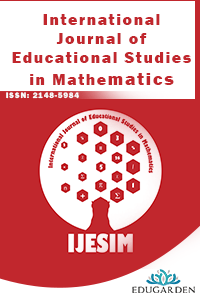Attitudes regarding Perceived Values and Usefulness of Mathematics in a Community College Mathematical Literacy Course
Attitudes regarding Perceived Values and Usefulness of Mathematics in a Community College Mathematical Literacy Course
___
- Allen, K. (2011). Mathematics as thinking: A response to “Democracy and math.” Democracy and Education, 19(2), 1-7.
- Bailey, T. (2009). Challenge and opportunity: Rethinking the role and function of developmental education in community college. New Directions for Community Colleges, 145, 11-30.
- Bailey, T., Jeong, D. W., & Cho, S.-W. (2010). Referral, enrollment, and completion in developmental education sequences in community college. Economics of Education Review, 29, 255–270. doi: 10.1016/j.econedurev.2009.09.002
- Carnegie Foundation. (n.d.). Quantway. Retrieved on July 31, 2012 from http://www.carnegiefoundation.org/quantway.
- Creswell, J. (2018). Research design: Qualitative, quantitative and mixed methods approaches (5th ed.). Thousand Oaks, CA: Sage.
- CUNY, Office of Institutional Research and Assessment. (2015). Pass rates of selected math courses: Fall 2014. Unpublished data report.
- George, M. (2010). Ethics and motivation in remedial mathematics education. Community College Review, 38, 82–92. doi: 10.1177/0091552110373385
- Howell, J. S. (2011). What influences students’ need for remediation in college? Evidence from California. Journal of Higher Education, 82, 292–318. doi: 10.1353/jhe.2011.0014
- Jordan, J., & Haines, B. (2003). Fostering quantitative literacy: Clarifying goals, assessing student progress. Peer Review, 5(4), 16-19.
- Koller, O., Baumert, J., & Schnabel, K. (2001). Does interest matter? The relationship between academic interest and achievement in mathematics. Journal for Research in Mathematics Education, 32(5), 448-470.
- Malcom, S. (1997). Making mathematics the great equalizer. In L. A. Steen (Ed.), Why numbers count: Quantitative literacy for tomorrow’s America (pp. 30-35). New York, NY: College Board.
- Mejia, M. C., Rodriguez, O., & Johnson, H. (2016). Preparing students for success in California community colleges (Public Policy Institute of California). Retrieved from http://www.ppic.org/content/pubs/report/ R_1116MMR.pdf
- Middleton, J. A., & Spanias, P. A. (1999). Motivation for achievement in mathematics: Findings, generalizations, and criticisms of the research. Journal for Research in Mathematics Education, 30(1), 65–88.
- Nunan, D. (1999). Research methods in language learning (8th printing). Cambridge: CUP
- Schiefele, U., & Csikszentmihalyi, M. (1995). Motivation and ability as factors in mathematics experience and achievement. Journal for Research in Mathematics Education, 26(2), 163-181.
- Steen, L. A. (2001c). Mathematics and numeracy: Two literacies, one language. Mathematics Educator, 6(1), 10-16.
- Stith, J. H. (2001). Connecting theory and practice. In L. A. Steen (Ed.), Mathematics and democracy: The case for quantitative literacy (pp. 73-78). Washington, DC: National Council on Education and the Disciplines.
- Tapia, M. (1996). The attitudes toward mathematics instrument. Retrieved from http://search.proquest.com.proxy.lib.wayne.edu/docview/62613882?accountid 14925
- Van Peursem, D., Keller, C., Pietrzak, Wagner, C., & Bennett, C. (2012). A comparison of performance and attitudes between students enrolled in college algebra vs. quantitative literacy. Mathematics and Computer Education, 46(2), 107-118.
- Yayın Aralığı: Yılda 4 Sayı
- Başlangıç: 2014
- Yayıncı: Ercan MASAL
Ergenlik Öncesi Öğrencilerin Matematiğe Yönelik Başarı Duyguları Ölçeğinin Türkçeye Uyarlanması
Mithat TAKUNYACI, Buket KARADAĞ
6. Sınıf Öğrencilerinin Alan Ölçme İle İlgili Problem Çözme Becerileri
Developing an Observation Form to Determine the TPACK Usage
Rabia Gül KIRIKÇILAR, Avni YILDIZ
Victor MARTİNEZ-LUACES, José Antonio FERNÁNDEZ PLAZA, Luis RİCO
